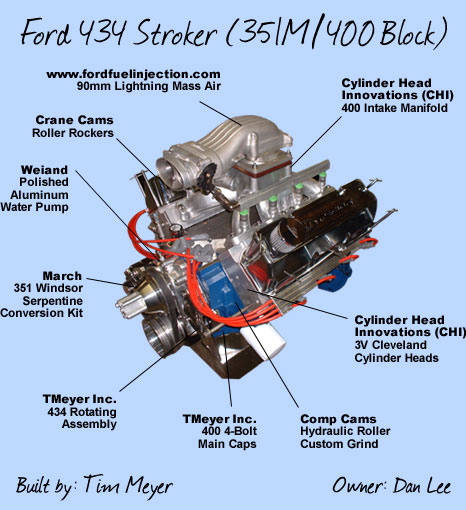All, at the last meeting I told you that Papatom donated a 351w to the club well it turns out to be a 400 CID motor from the Ford 335 engine family built by the Ford Motor Company between 1970 and 1982.
These are the casting numbers I have found on the motor.
CASTING NUMBERS
BLOCK D4AE-B2A 5H15
HEADS D5AE-A2A 6L15
CONNECTING RODS D1AE-6210-AA
MAIN CAPS D1A-E-AA
CRANK 5MAB
400M
The big-block FE engine family was getting rather tired and outdated, and the 385 family could not meet the efficiency requirements of the time. At the same time, the small-block Windsor engines were too small and high-revving for Ford's fullsize car and truck applications. So the company went to work on a new small-block to meet the desired levels of economy while still providing the kind of big-block torque that was needed to move 2+ ton vehicles.
The Ford 400 engine was based on the 351 Cleveland but was produced with a half inch taller deck height to allow for a crankshaft with a longer stroke. The 400 also featured larger main-bearing journals and had "square" proportions, with a 4.0 in (102 mm) bore and stroke; it therefore displaced 402 cu in (6.6 L), making it the largest small-block V8 made at that time. It was introduced in model year 1971 with a full half-inch (12.7 mm) longer stroke than the 351 Cleveland, making it the longest-stroke Ford pushrod V8 engine. A long-stroke engine has good low-end torque. This was a good compromise given Ford's requirement for an engine to power heavier mid-size and full-size cars and light trucks. The M-block, as it later became known, was the last pushrod V8 block designed by Ford. The M-block also shares some elements with the Windsor engine family: bore spacing, cylinder head bolt-patterns and crankshaft journal dimensions.[1]
The 400 was seen as a smaller and lighter replacement for the big Ford 385 engines, the 429 and 460, in Ford's big cars. Weighing just 80% of a similar big block, it was originally available in Ford's Custom, Galaxie and LTD lines, and in Mercury's Monterey, Marquis, and Brougham. Later, it would power the Ford Thunderbird, the Lincoln Continental, Mark V, mid-size Fords and Mercurys, and Ford light-duty trucks.
The vast majority of 400 blocks use the same bellhousing bolt pattern as the 385 family big-block to make it compatible with the higher torque-capacity C6 transmission used on the large cars and trucks. There were a small number of 400 block castings that use a "small block" pattern on the rear for mounting an FMX transmission. These castings are rare. The 400 was modified in 1975 to use unleaded gasoline.
On the other hand, an M-block engine in factory trim has vast, untapped power potential. It is smaller and lighter than a big block (which is why it was developed in the first place), and when properly built, the M-block's power output is comparable to most big blocks.*
Please Help me do research on this motor...
Links I have found

1. 400M
2. Over 500HP and 565lb-ft from Ford's 400M
3. 400M
These are the casting numbers I have found on the motor.
CASTING NUMBERS
BLOCK D4AE-B2A 5H15
HEADS D5AE-A2A 6L15
CONNECTING RODS D1AE-6210-AA
MAIN CAPS D1A-E-AA
CRANK 5MAB
400M
The big-block FE engine family was getting rather tired and outdated, and the 385 family could not meet the efficiency requirements of the time. At the same time, the small-block Windsor engines were too small and high-revving for Ford's fullsize car and truck applications. So the company went to work on a new small-block to meet the desired levels of economy while still providing the kind of big-block torque that was needed to move 2+ ton vehicles.
The Ford 400 engine was based on the 351 Cleveland but was produced with a half inch taller deck height to allow for a crankshaft with a longer stroke. The 400 also featured larger main-bearing journals and had "square" proportions, with a 4.0 in (102 mm) bore and stroke; it therefore displaced 402 cu in (6.6 L), making it the largest small-block V8 made at that time. It was introduced in model year 1971 with a full half-inch (12.7 mm) longer stroke than the 351 Cleveland, making it the longest-stroke Ford pushrod V8 engine. A long-stroke engine has good low-end torque. This was a good compromise given Ford's requirement for an engine to power heavier mid-size and full-size cars and light trucks. The M-block, as it later became known, was the last pushrod V8 block designed by Ford. The M-block also shares some elements with the Windsor engine family: bore spacing, cylinder head bolt-patterns and crankshaft journal dimensions.[1]
The 400 was seen as a smaller and lighter replacement for the big Ford 385 engines, the 429 and 460, in Ford's big cars. Weighing just 80% of a similar big block, it was originally available in Ford's Custom, Galaxie and LTD lines, and in Mercury's Monterey, Marquis, and Brougham. Later, it would power the Ford Thunderbird, the Lincoln Continental, Mark V, mid-size Fords and Mercurys, and Ford light-duty trucks.
The vast majority of 400 blocks use the same bellhousing bolt pattern as the 385 family big-block to make it compatible with the higher torque-capacity C6 transmission used on the large cars and trucks. There were a small number of 400 block castings that use a "small block" pattern on the rear for mounting an FMX transmission. These castings are rare. The 400 was modified in 1975 to use unleaded gasoline.
On the other hand, an M-block engine in factory trim has vast, untapped power potential. It is smaller and lighter than a big block (which is why it was developed in the first place), and when properly built, the M-block's power output is comparable to most big blocks.*
Please Help me do research on this motor...
Links I have found

1. 400M
2. Over 500HP and 565lb-ft from Ford's 400M
3. 400M



